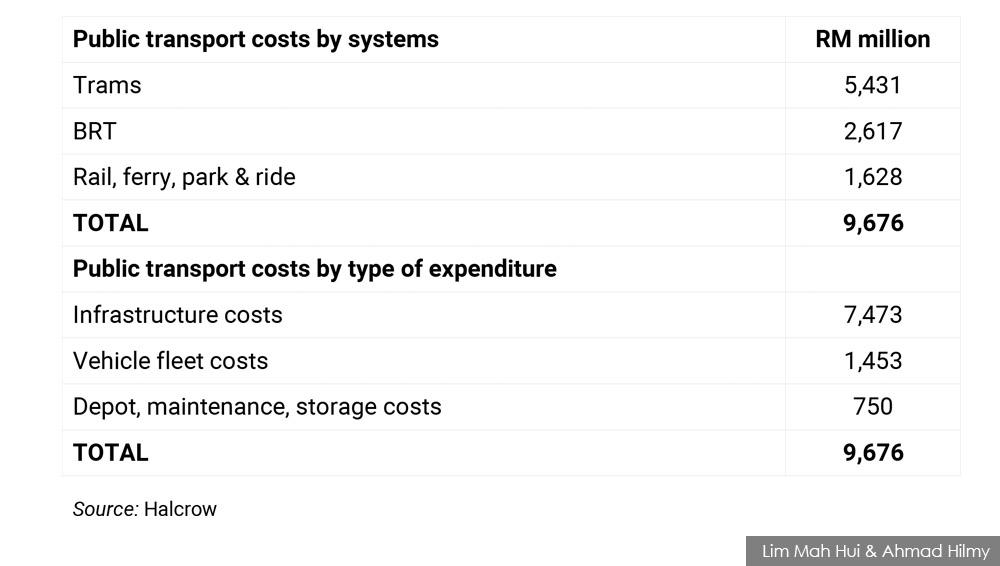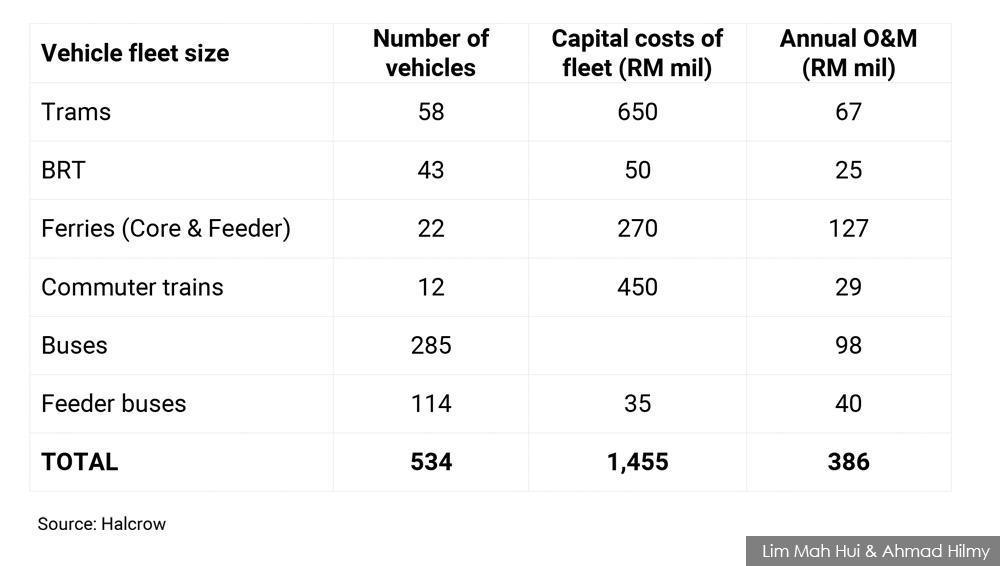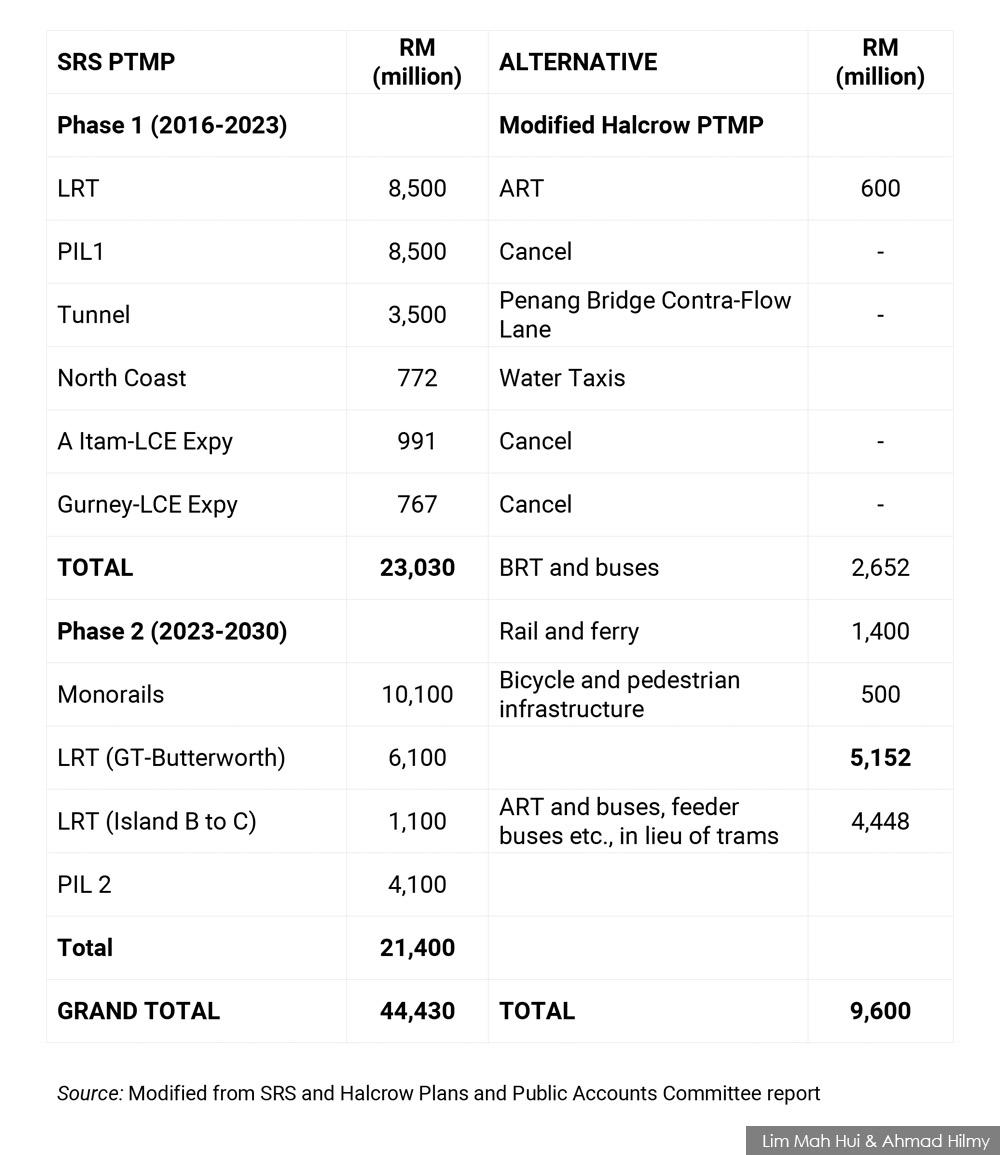COMMENT | A fully-integrated public transport system based on the modification of the Halcrow Plan can be implemented at less than RM10 billion in place of the overblown RM46 billion Penang Transport Master Plan (PTMP).
What is the alternative?
The alternative is to revisit the Halcrow Consultants master plan with the introduction of minor modifications.
Halcrow’s three-volume study over 18 months offers a detailed description of the public transport systems with capital expenditure, as well as operating and maintenance costs.
It had proposed an integrated public transport system that includes trams, BRT, buses, feeder buses, commuter rail, and ferries.
- Three major tram routes totalling 60km radiating from George Town: One to Tanjong Bungah in the north, one to Bayan Lepas in the south and one to Ayer Itam/PayaTerubong in the northwest. Two shorter tram lines loop within George Town.
- Three BRT routes: Two on the mainland (one from Butterworth to Macang Bubok, the other serving the Southern Corridor from Butterworth to Simpang Empat), the third serving Bayan Lepas-FTZ zone.
- One commuter rail from Pinang Tunggal to Nibong Tebal
- Ferries from Butterworth to George Town; Butterworth to Gurney/Queensbay; Queensbay to Weld Quay
The table below shows the cost of public transport by type of system and by expenditure.

The total estimated cost is RM9.7 billion, with trams accounting for RM5.4 billion, BRT RM2.6 billion, and rail and ferry RM1.6 billion.
In terms of type of expenditure, 77 percent is spent on infrastructure costs, 15 percent on vehicle fleet costs and eight percent on depot, maintenance and storage.
The table below shows the range of vehicles and vehicle fleet size for the proposed public transport systems. The total price of purchasing 534 units of different public transport systems was RM1.45 billion.

The public transport system would have 58 trams, 43 BRT buses, 22 ferries, 12 commuter trains, 114 feeder buses.
There is no capital cost for the 285 buses as Rapid Penang already owns and operates about 300 buses. The annual operating and maintenance costs for the public transport system is RM386 million.
The fleet of buses, ferries and commuter trains can now be expanded unlike previously when they were under the BN government.
With the above information, we can now compare what Halcrow Plan offers to what the SRS Consortium Plan offers.
In short, the cost of building one LRT route (most recent cost RM10 billion) or one Pan Island Link 1 highway, parallel in direction to the LRT line (most recent cost RM9.6 billion) is the price of providing an integrated public transport system for almost the entire Penang state (RM9.6 billion).
Phase 1 alone of the SRS and Zenith package would cost RM23 billion, and the only public transport system in that package is the single LRT line. All of this money is spent on Penang island, with nothing for the mainland.
We are, however, in 2019 now, not 2012. A lot has happened in those seven years.
Most significantly, Pakatan Harapan now controls the federal government and Penang. Secondly, technology has changed significantly. We have today a better, cheaper and faster as with the ART system.
The three major tram lines in the Halcrow Plan (60km in length) cost RM5.4 billion. Today it is possible to build these three lines for RM1.5 billion using the ART technology (taking the higher estimate of RM24 million per km).
Taking into account these two major developments, we propose a modified Halcrow Plan as an alternative.

Under this alternative, PIL1 and the Zenith package (including the cross-channel tunnel) are cancelled.
In place of the North Coast Paired Road, we propose coastal water taxis. LRT and monorails are replaced with ART.
There is room and budget to introduce more feeder buses, bicycling and pedestrian infrastructure, and improve the first and last-mile connectivity. The cost would still be under RM10 billion.
Summary of alternatives
Good network of ART and BRTs supported by feeder systems to address first and last-mile connectivity. It is easy to run BRT or ART on major arterial roads. Providing a good feeder system is the challenging part. We need to be creative here. Bring back mini-buses, ojaks, park-and-ride bicycles, e-hailing services etc. Get the private sector to do part of this.
Bus-high occupancy vehicle lanes to be introduced along the first Penang Bridge. Similar lanes can be tried out in major arterial roads on the island and mainland during peak hours.
Better utilisation of water transport. Surrounded by seas, more investment must go to improve water transport as a mode of public transportation. Upgrading the cross-channel ferry system should be a top priority to alleviate cross-channel traffic problems instead of the tunnel.
Water taxis should be developed to connect the northern and southern parts of the island to George Town – from Queensbay Mall in the south to town, and from Batu Ferringhi in the north to town. If this is well developed, there is no need for the North Coast Paired Road (under the Zenith package).
Invest more in cycling and pedestrian infrastructure. Only in the last three years, Singapore has taken this concept seriously and made good strides in this direction. We can learn from them.
The first thing to do is to commission a serious master plan for cycling. To overcome two major factors working against bicycling (heat and safety), plant more shady trees along roads and provide safe bicycle lanes. Contra-flow bicycle lanes are used successfully in many cities.
Strict enforcement of traffic rules. A great part of Penang’s traffic jam is also caused by illegal parking and poor enforcement by local authorities. This is particularly acute near schools during school closing hours.
This can be solved by the partial 'privatisation' of enforcement, such as commissioning private operators to tow cars but under the strict control and supervision of local councils.
Balanced and sustainable development. The state has consistently talked about balanced development between the island and mainland. The Penang Development Corp has about 4,500 acres of land on the mainland.
This is a great opportunity to put that policy into practice. It should focus on developing Batu Kawan and other neighbouring sites into the second high-tech industrial zone of Penang. This new industrial zone is only 15 minutes to the island via the Second Bridge.
Funding
Our back-of-envelope estimation of the cost of these alternatives is below RM10 billion. So where would the money come from?
It will come from savings from cancelling the Zenith Projects, the sale of Sungai Nibong land owned by the state, and federal funding.
The Penang government needs to request for RM2.6 billion, not RM10 billion or RM20 billion from the federal government to address its transport woes.

PART 1
A better, cheaper alternative to the RM46 billion PTMP
PART 2
Is LRT the best public transportation option for Penang?
LIM MAH HUI is a former professor, international banker and Penang Island City Council for six years. AHMAD HILMY is a transport engineer who teaches at Universiti Sains Malaysia.
The views expressed here are those of the author/contributor and do not necessarily represent the views of Malaysiakini.

